Designing and Synthesis of New Isatin Derivatives as Potential CDK2 Inhibitors
Abstract
:1. Introduction
2. Results and Discussion
2.1. Design and Computational Analysis of Binding Activity
2.2. Synthesis and NMR Data
2.3. Infrared Spectral Studies
2.4. Spectroscopic Properties
3. Materials and Methods
3.1. Computational Methods
3.1.1. The Docking Procedure
3.1.2. The Molecular Dynamics Simulations
3.1.3. The Quantum Mechanics Calculations
3.2. Materials
3.3. Synthesis
3.4. Experimental Measurements
3.4.1. NMR Measurements
3.4.2. Elemental Analysis Measurements
3.4.3. UV–VIS Measurements
3.4.4. FTIR Measurements
3.4.5. The Calorimetric Measurements
4. Conclusions
Supplementary Materials
Author Contributions
Funding
Institutional Review Board Statement
Informed Consent Statement
Data Availability Statement
Acknowledgments
Conflicts of Interest
References
- Zhou, J.; Qu, F. Analysis of the Extracts of Isatis tinctoria by New Analytical Approaches of HPLC, MS and NMR. Afr. J. Tradit. Complement. Altern. Med. 2011, 8, 33–45. [Google Scholar] [CrossRef] [Green Version]
- Bergman, J.; Lindström, J.-O.; Tilstam, U. The structure and properties of some indolic constituents in Couroupita guianensis aubl. Tetrahedron 1985, 41, 2879–2881. [Google Scholar] [CrossRef]
- Bayly, M.J.; Duretto, M.F.; Holmes, G.D.; Forster, P.I.; Cantrill, D.J.; Ladiges, P.Y.; Bayly, M.J.; Duretto, M.F.; Holmes, G.D.; Forster, P.I.; et al. Transfer of the New Caledonian genus Boronella to Boronia (Rutaceae) based on analyses of cpDNA and nrDNA. Aust. Syst. Bot. 2015, 28, 111. [Google Scholar] [CrossRef]
- Xiao, Z.; Hao, Y.; Liu, B.; Qian, L. Indirubin and Meisoindigo in the Treatment of Chronic Myelogenous Leukemia in China. Leuk. Lymphoma 2002, 43, 1763–1768. [Google Scholar] [CrossRef]
- Hoessel, R.; Leclerc, S.; Endicott, J.A.; Nobel, M.E.M.; Lawrie, A.; Tunnah, P.; Leost, M.; Damiens, E.; Marie, D.; Marko, D.; et al. Indirubin, the active constituent of a Chinese antileukaemia medicine, inhibits cyclin-dependent kinases. Nat. Cell Biol. 1999, 1, 60–67. [Google Scholar] [CrossRef]
- Cheke, R.S.; Firke, S.D.; Patil, R.R.; Bari, S.B. ISATIN: New Hope Against Convulsion. Cent. Nerv. Syst. Agents Med. Chem. 2018, 18, 76–101. [Google Scholar] [CrossRef]
- Bharathi Dileepan, A.G.; Daniel Prakash, T.; Ganesh Kumar, A.; Shameela Rajam, P.; Violet Dhayabaran, V.; Rajaram, R. Isatin based macrocyclic Schiff base ligands as novel candidates for antimicrobial and antioxidant drug design: In vitro DNA binding and biological studies. J. Photochem. Photobiol. B Biol. 2018, 183, 191–200. [Google Scholar] [CrossRef]
- Guo, H. Isatin derivatives and their anti-bacterial activities. Eur. J. Med. Chem. 2019, 164, 678–688. [Google Scholar] [CrossRef]
- Zhang, M.-Z.; Chen, Q.; Yang, G.-F. A review on recent developments of indole-containing antiviral agents. Eur. J. Med. Chem. 2015, 89, 421–441. [Google Scholar] [CrossRef]
- Prakash, C.R.; Theivendren, P.; Raja, S.; Prakash, C.R.; Theivendren, P.; Raja, S. Indolin-2-Ones in Clinical Trials as Potential Kinase Inhibitors: A Review. Pharmacol. Pharm. 2012, 3, 62–71. [Google Scholar] [CrossRef] [Green Version]
- Nikoulina, S.E.; Ciaraldi, T.P.; Mudaliar, S.; Carter, L.; Johnson, K.; Henry, R.R. Inhibition of glycogen synthase kinase 3 improves insulin action and glucose metabolism in human skeletal muscle. Diabetes 2002, 51, 2190–2198. [Google Scholar] [CrossRef] [Green Version]
- Kim, S.-A.; Kwon, S.-M.; Kim, J.-A.; Kang, K.W.; Yoon, J.-H.; Ahn, S.-G. 5′-Nitro-indirubinoxime, an indirubin derivative, suppresses metastatic ability of human head and neck cancer cells through the inhibition of Integrin β1/FAK/Akt signaling. Cancer Lett. 2011, 306, 197–204. [Google Scholar] [CrossRef]
- Martin, L.; Magnaudeix, A.; Wilson, C.M.; Yardin, C.; Terro, F. The new indirubin derivative inhibitors of glycogen synthase kinase-3, 6-BIDECO and 6-BIMYEO, prevent tau phosphorylation and apoptosis induced by the inhibition of protein phosphatase-2A by okadaic acid in cultured neurons. J. Neurosci. Res. 2011, 89, 1802–1811. [Google Scholar] [CrossRef]
- Avila, J.; Hernández, F. GSK-3 inhibitors for Alzheimer’s disease. Expert Rev. Neurother. 2007, 7, 1527–1533. [Google Scholar] [CrossRef]
- Czeleń, P. Investigation of the Inhibition Potential of New Oxindole Derivatives and Assessment of Their Usefulness for Targeted Therapy. Symmetry 2019, 11, 974. [Google Scholar] [CrossRef] [Green Version]
- Bramson, H.N.; Holmes, W.D.; Hunter, R.N.; Lackey, K.E.; Lovejoy, B.; Luzzio, M.J.; Montana, V.; Rocque, W.J.; Rusnak, D.; Shewchuk, L.; et al. Oxindole-based inhibitors of cyclin-dependent kinase 2 (CDK2): Design, synthesis, enzymatic activities, and X-ray crystallographic analysis. J. Med. Chem. 2001, 44, 4339–4358. [Google Scholar] [CrossRef]
- Czeleń, P.; Szefler, B. The oxindole derivatives, new promising gsk-3β inhibitors as one of the potential treatments for alzheimer’s disease—A molecular dynamics approach. Biology 2021, 10, 332. [Google Scholar] [CrossRef]
- Shin, E.-K.; Kim, J.-K. Indirubin derivative E804 inhibits angiogenesis. BMC Cancer 2012, 12, 164. [Google Scholar] [CrossRef] [Green Version]
- Lee, M.-Y.; Liu, Y.-W.; Chen, M.-H.; Ww, J.-Y.; Ho, H.-Y.; Wang, Q.-F.; Chuang, J.-J. Indirubin-3′-monoxime promotes autophagic and apoptotic death in JM1 human acute lymphoblastic leukemia cells and K562 human chronic myelogenous leukemia cells. Oncol. Rep. 2013, 29, 2072–2078. [Google Scholar] [CrossRef] [Green Version]
- Lozinskaya, N.A.; Babkov, D.A.; Zaryanova, E.V.; Bezsonova, E.N.; Efremov, A.M.; Tsymlyakov, M.D.; Anikina, L.V.; Zakharyascheva, O.Y.; Borisov, A.V.; Perfilova, V.N.; et al. Synthesis and biological evaluation of 3-substituted 2-oxindole derivatives as new glycogen synthase kinase 3β inhibitors. Bioorg. Med. Chem. 2019, 27, 1804–1817. [Google Scholar] [CrossRef]
- de Paiva, R.E.F.; Vieira, E.G.; da Silva, D.R.; Wegermann, C.A.; Ferreira, A.M.C. Anticancer Compounds Based on Isatin-Derivatives: Strategies to Ameliorate Selectivity and Efficiency. Front. Mol. Biosci. 2021, 7, 511. [Google Scholar]
- Besson, A.; Dowdy, S.F.; Roberts, J.M. CDK Inhibitors: Cell Cycle Regulators and Beyond. Dev. Cell 2008, 14, 159–169. [Google Scholar] [CrossRef] [Green Version]
- Malumbres, M.; Barbacid, M. Cell cycle, CDKs and cancer: A changing paradigm. Nat. Rev. Cancer 2009, 9, 153–166. [Google Scholar] [CrossRef]
- Morgan, D.O. CYCLIN-DEPENDENT KINASES: Engines, Clocks, and Microprocessors. Annu. Rev. Cell Dev. Biol. 1997, 13, 261–291. [Google Scholar] [CrossRef]
- Davies, T.G.; Tunnah, P.; Meijer, L.; Marko, D.; Eisenbrand, G.; Endicott, J.A.; Noble, M.E. Inhibitor binding to active and inactive CDK2: The crystal structure of CDK2-cyclin A/indirubin-5-sulphonate. Structure 2001, 9, 389–397. [Google Scholar] [CrossRef]
- Czeleń, P.; Szefler, B. Molecular dynamics study of the inhibitory effects of ChEMBL474807 on the enzymes GSK-3β and CDK-2. J. Mol. Model. 2015, 21, 74. [Google Scholar] [CrossRef] [Green Version]
- Czeleń, P. Molecular dynamics study on inhibition mechanism of CDK-2 and GSK-3β by CHEMBL272026 molecule. Struct. Chem. 2016, 27, 1807–1818. [Google Scholar] [CrossRef] [Green Version]
- Katiyar, A.; Hegde, M.; Kumar, S.; Gopalakrishnan, V.; Bhatelia, K.D.; Ananthaswamy, K.; Ramareddy, S.A.; de Clercq, E.; Choudhary, B.; Schols, D.; et al. Synthesis and evaluation of the biological activity of N′-[2-oxo-1,2 dihydro-3H-indol-3-ylidene] benzohydrazides as potential anticancer agents. RSC Adv. 2015, 5, 45492–45501. [Google Scholar] [CrossRef]
- Debnath, K.; Pathak, S.; Pramanik, A. Facile synthesis of ninhydrin and isatin based hydrazones in water using PEG-OSO3H as a highly efficient and homogeneous polymeric acid-surfactant combined catalyst. Tetrahedron Lett. 2013, 54, 4110–4115. [Google Scholar] [CrossRef]
- Abo-Ashour, M.F.; Eldehna, W.M.; Nocentini, A.; Ibrahim, H.S.; Bua, S.; Abou-Seri, S.M.; Supuran, C.T. Novel hydrazido benzenesulfonamides-isatin conjugates: Synthesis, carbonic anhydrase inhibitory activity and molecular modeling studies. Eur. J. Med. Chem. 2018, 157, 28–36. [Google Scholar] [CrossRef]
- Emami, S.; Valipour, M.; Komishani, F.K.; Sadati-Ashrafi, F.; Rasoulian, M.; Ghasemian, M.; Tajbakhsh, M.; Masihi, P.H.; Shakiba, A.; Irannejad, H.; et al. Synthesis, in silico, in vitro and in vivo evaluations of isatin aroylhydrazones as highly potent anticonvulsant agents. Bioorg. Chem. 2021, 112, 104943. [Google Scholar] [CrossRef]
- Hunoor, R.S.; Patil, B.R.; Badiger, D.S.; Chandrashekhar, V.M.; Muchchandi, I.S.; Gudasi, K.B. Co(II), Ni(II), Cu(II) and Zn(II) complexes of isatinyl-2-aminobenzoylhydrazone: Synthesis, characterization and anticancer activity. Appl. Organomet. Chem. 2015, 29, 101–108. [Google Scholar] [CrossRef]
- Bartashevich, E.V.; Potemkin, V.A.; Grishina, M.A.; Belik, A.V. A Method for Multiconformational Modeling of the Three-Dimensional Shape of a Molecule. J. Struct. Chem. 2002, 43, 1033–1039. [Google Scholar] [CrossRef]
- Trott, O.; Olson, A.J. AutoDock Vina: Improving the speed and accuracy of docking with a new scoring function, efficient optimization, and multithreading. J. Comput. Chem. 2010, 31, 455–461. [Google Scholar] [CrossRef] [Green Version]
- Maier, J.A.; Martinez, C.; Kasavajhala, K.; Wickstrom, L.; Hauser, K.E.; Simmerling, C. ff14SB: Improving the Accuracy of Protein Side Chain and Backbone Parameters from ff99SB. J. Chem. Theory Comput. 2015, 11, 3696–3713. [Google Scholar] [CrossRef] [Green Version]
- Bayly, C.I.; Cieplak, P.; Cornell, W.; Kollman, P.A. A well-behaved electrostatic potential based method using charge restraints for deriving atomic charges: The RESP model. J. Phys. Chem. 1993, 97, 10269–10280. [Google Scholar] [CrossRef]
- Adelman, S.A. Generalized Langevin equation approach for atom/solid-surface scattering: General formulation for classical scattering off harmonic solids. J. Chem. Phys. 1976, 64, 2375. [Google Scholar] [CrossRef]
- Humphrey, W.; Dalke, A.; Schulten, K. VMD: Visual molecular dynamics. J. Mol. Graph. 1996, 14, 33–38. [Google Scholar] [CrossRef]
- Miller, B.R.; McGee, T.D.; Swails, J.M.; Homeyer, N.; Gohlke, H.; Roitberg, A.E. MMPBSA.py: An Efficient Program for End-State Free Energy Calculations. J. Chem. Theory Comput. 2012, 8, 3314–3321. [Google Scholar] [CrossRef]
- Case, D.A.; Babin, V.; Berryman, J.T.; Betz, R.M.; Cai, Q.; Cerutti, D.S.; Cheatham, T.E.; Darden, T.A., III; Duke, R.E.; Gohlke, H.; et al. AMBER 14 2014. Available online: https://www.researchgate.net/publication/270588529_Amber_2014 (accessed on 27 June 2022).
- Frisch, M.J.; Trucks, G.W.; Schlegel, H.B.; Scuseria, G.E.; Robb, M.A.; Cheeseman, J.R.; Scalmani, G.; Barone, V.; Petersson, G.A.; Nakatsuji, H.; et al. Gaussian 09, Revision A.02; Carnegie Mellon University: Pittsburgh, PA, USA, 2016. [Google Scholar]
- Cramer, C.J.; Truhlar, D.G. Implicit Solvation Models: Equilibria, Structure, Spectra, and Dynamics. Chem. Rev. 1999, 99, 2161–2200. [Google Scholar] [CrossRef]
- Barone, V.; Cossi, M.; Tomasi, J. A new definition of cavities for the computation of solvation free energies by the polarizable continuum model. J. Chem. Phys. 1997, 107, 3210–3221. [Google Scholar] [CrossRef]
- Marten, B.; Kim, K.; Cortis, C.; Friesner, R.A.; Murphy, R.B.; Ringnalda, M.N.; Sitkoff, D.; Honig, B. New model for calculation of solvation free energies: Correction of self-consistent reaction field continuum dielectric theory for short-range hydrogen-bonding effects. J. Phys. Chem. 1996, 100, 11775–11788. [Google Scholar] [CrossRef]
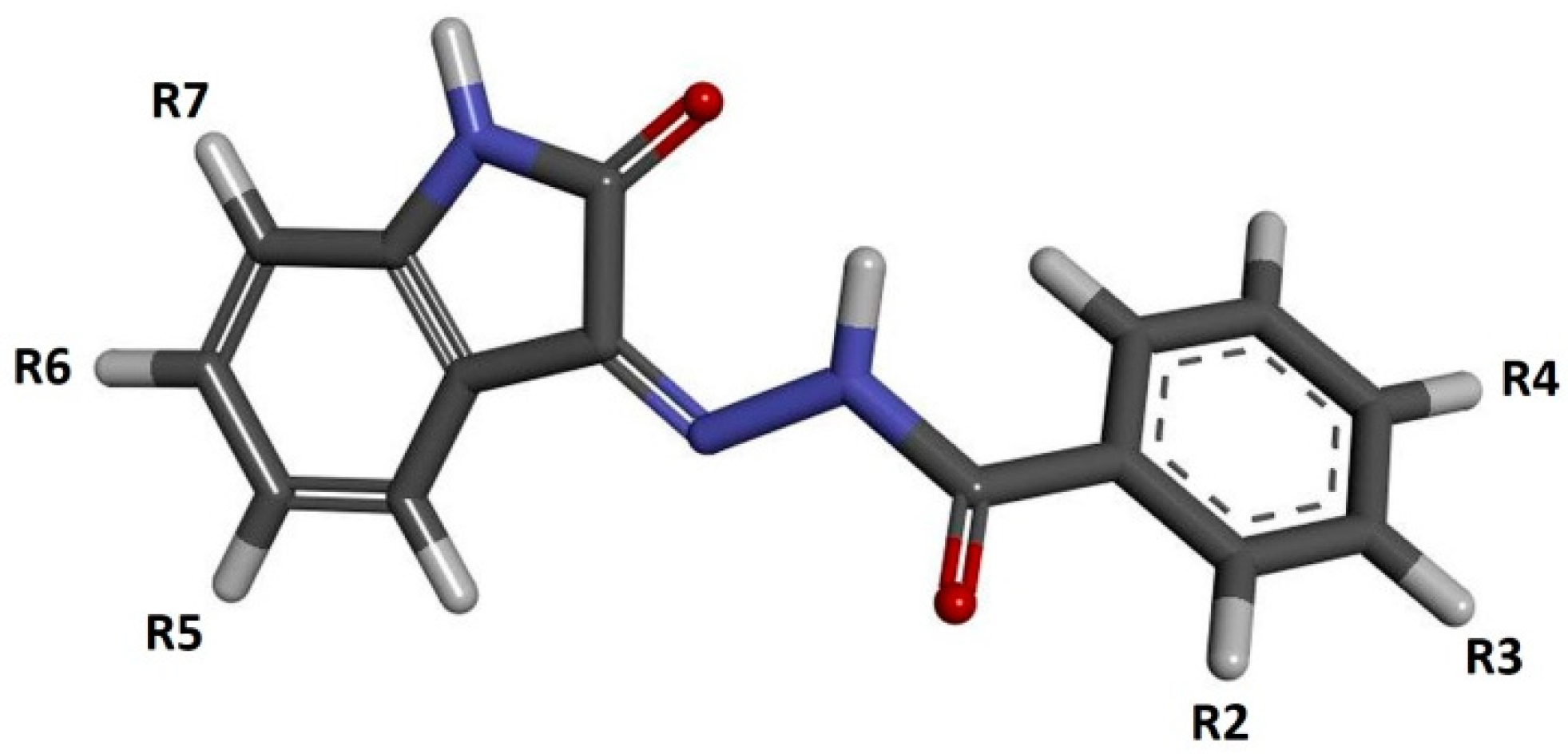

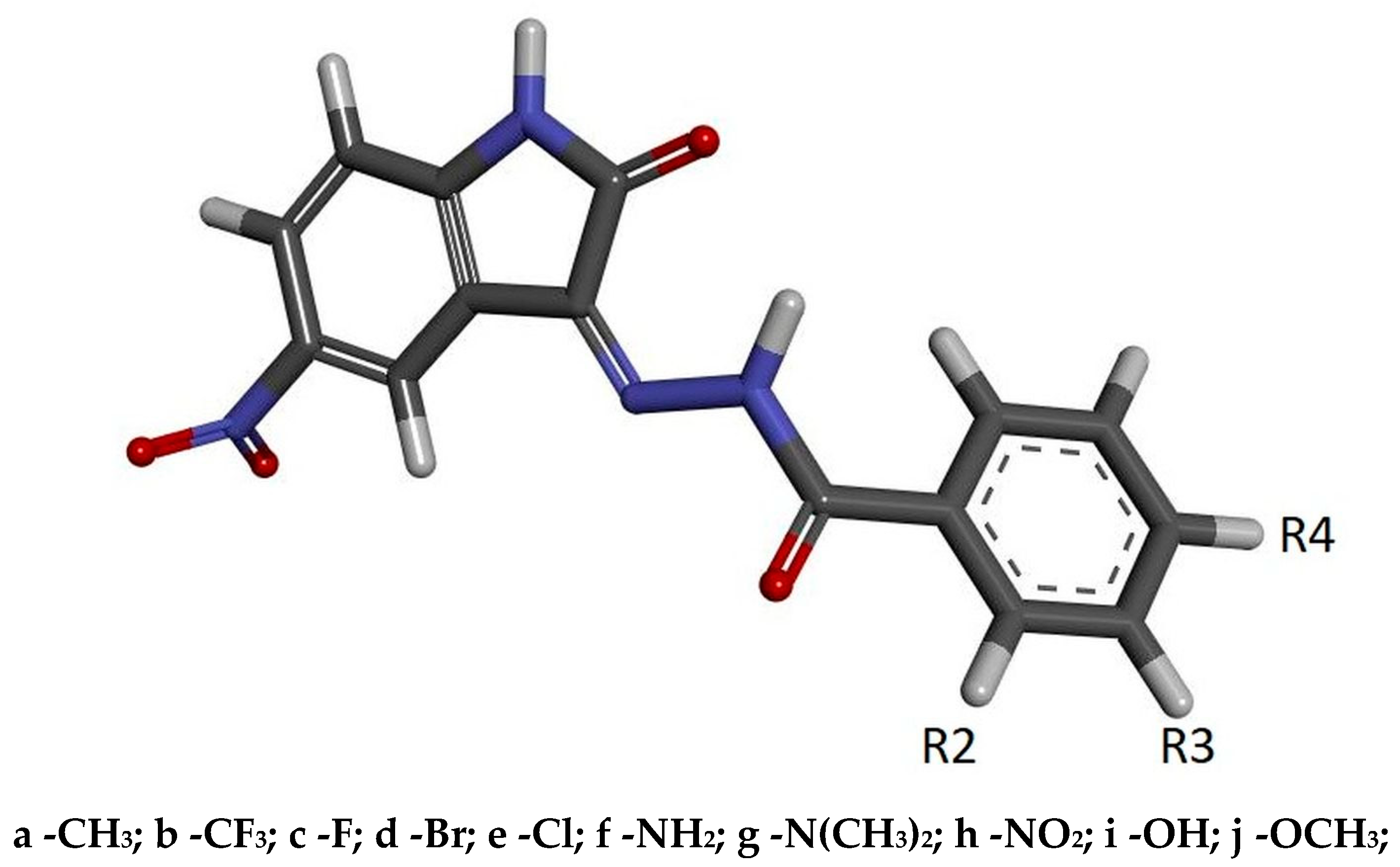
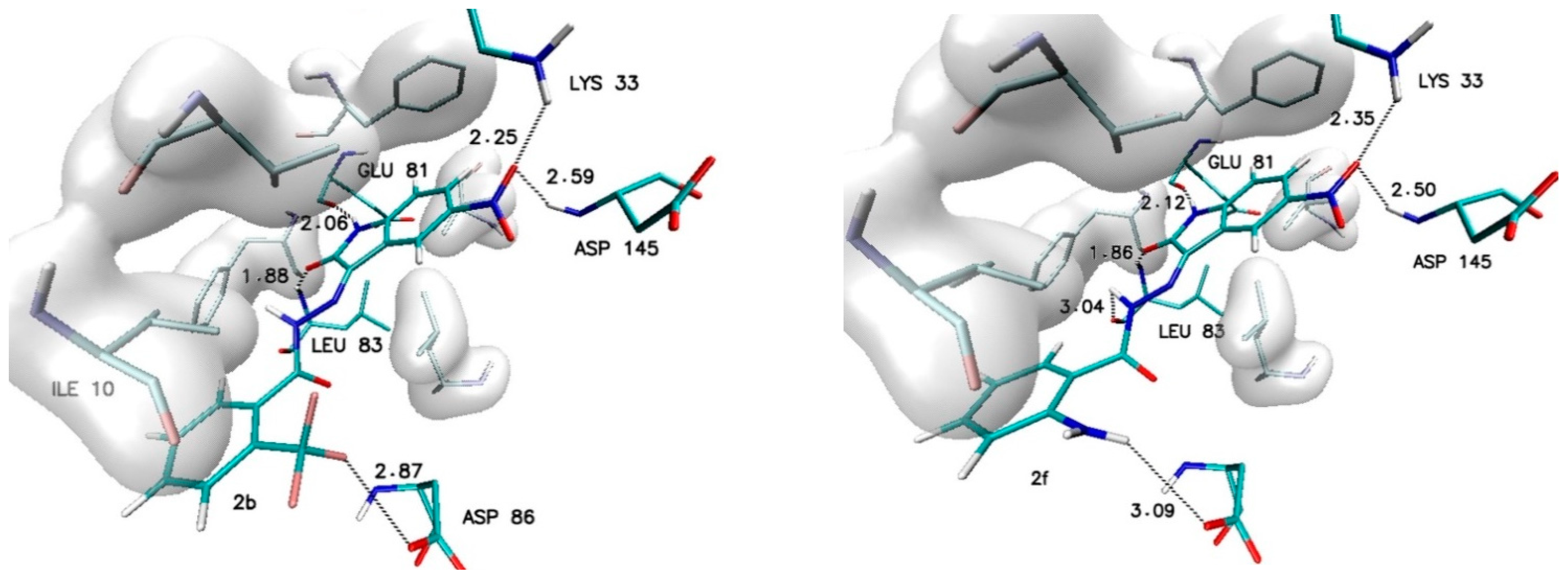

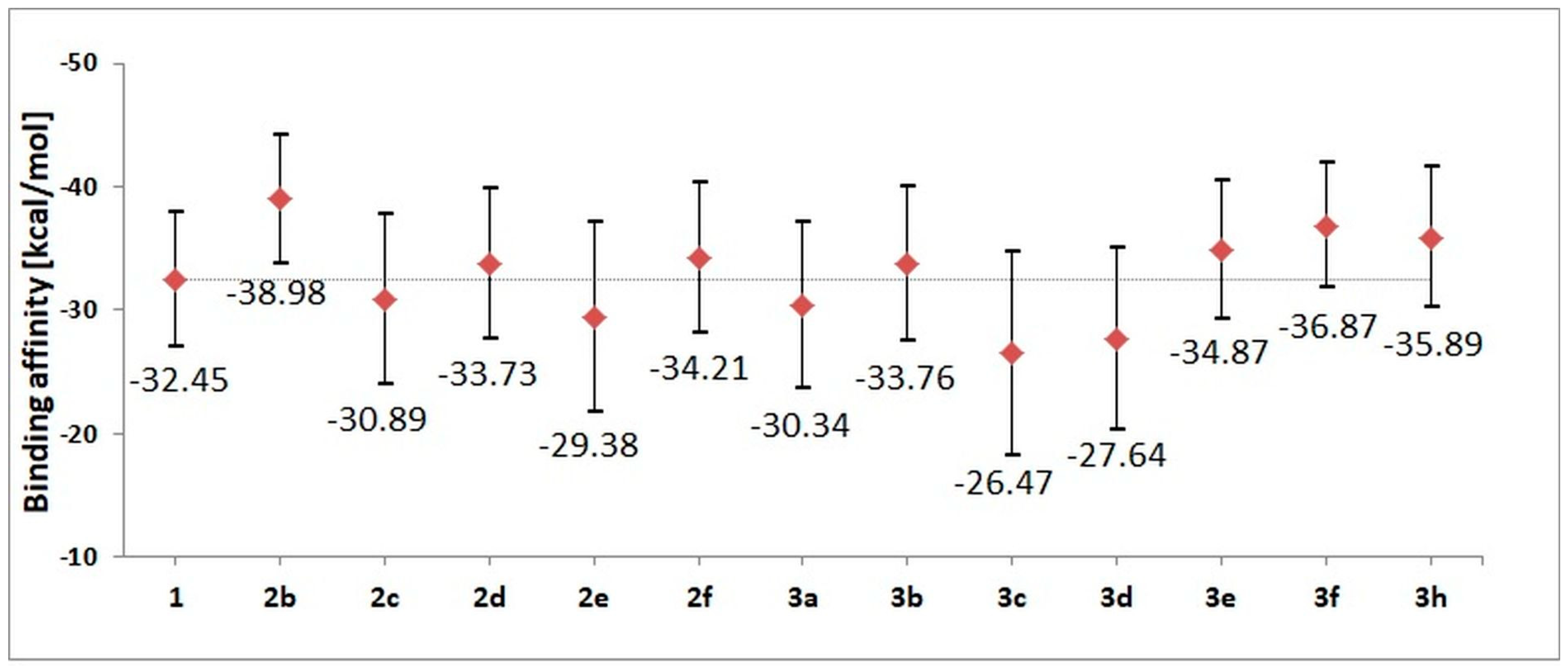
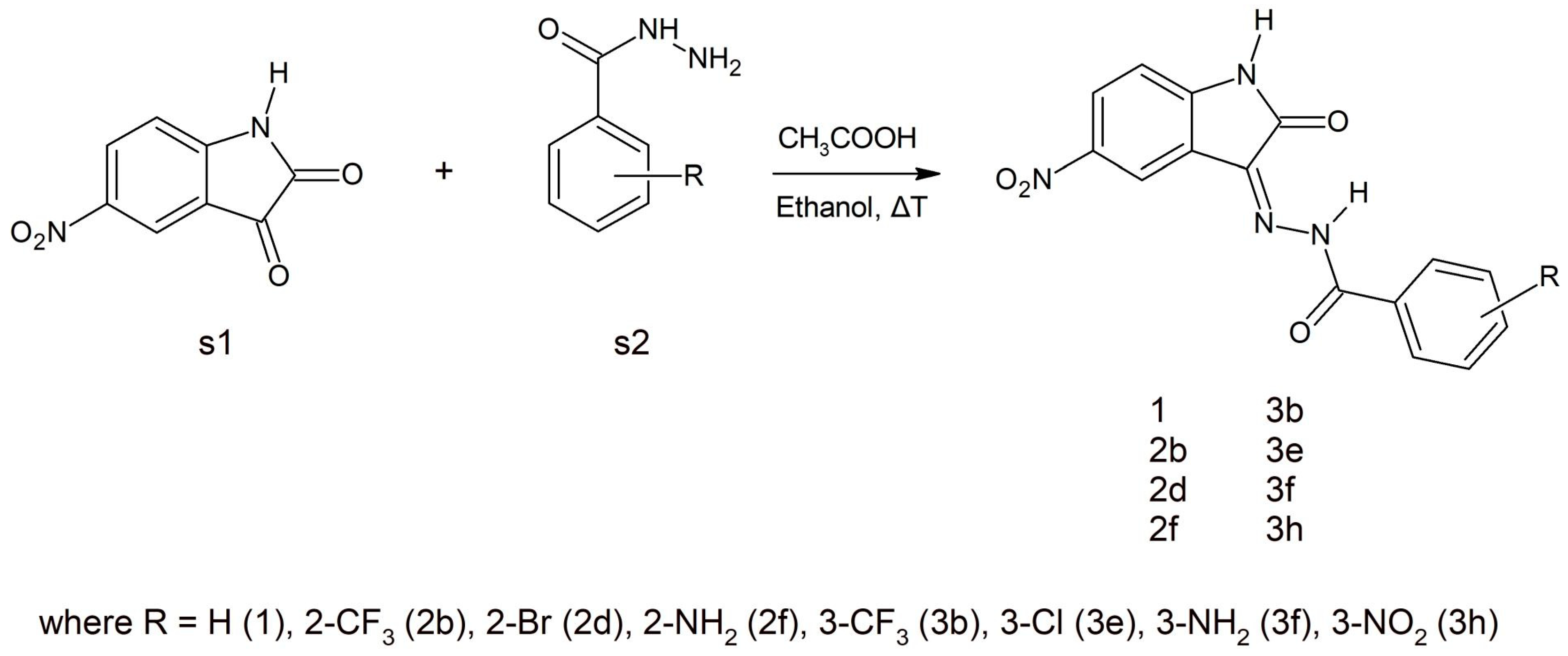

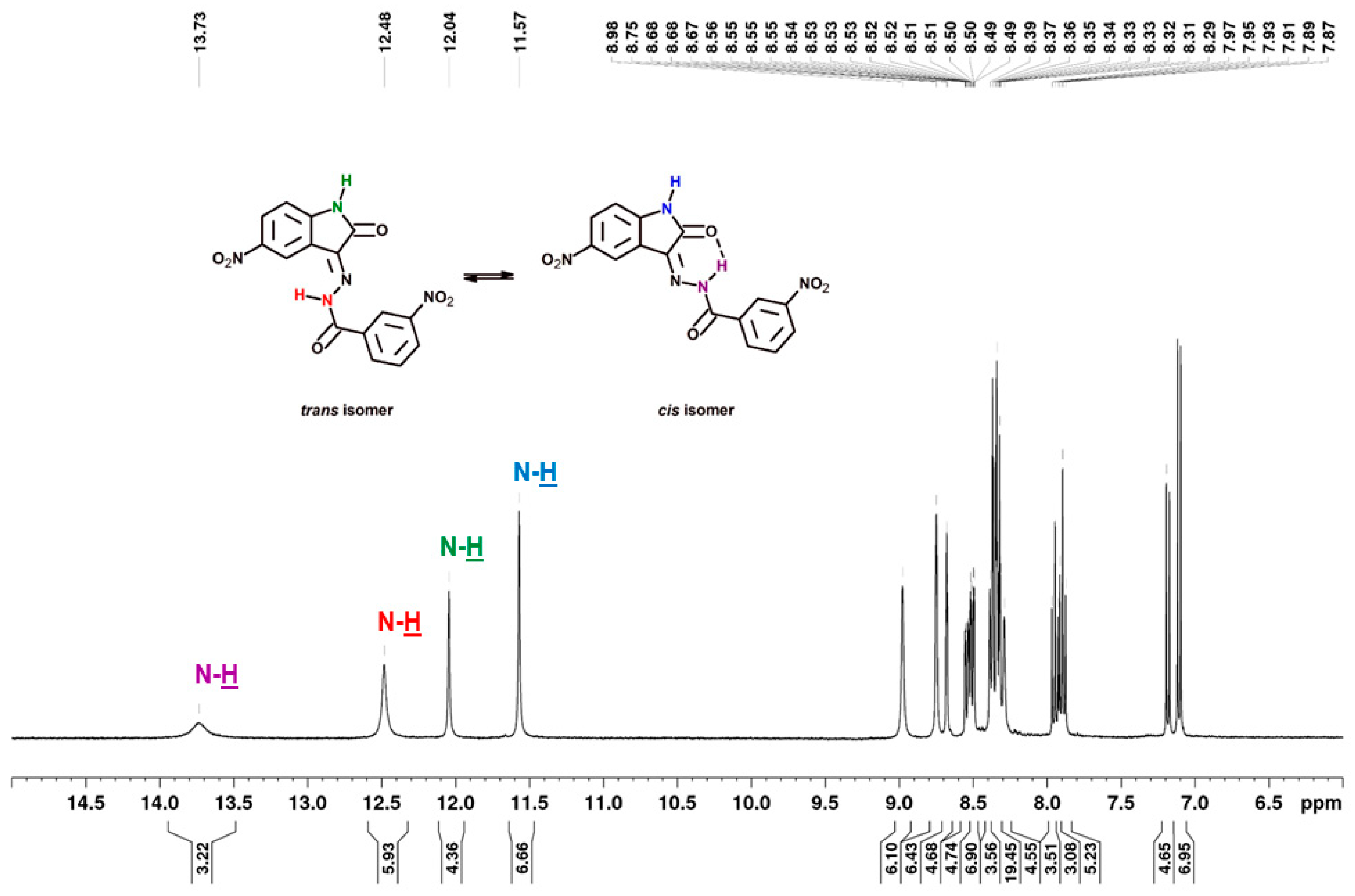

| Name of Substituent | ∆G Binding Affinity (kcal/mol) | ||
|---|---|---|---|
| R5 | R6 | R7 | |
| - I | −9.20 | −8.80 | −8.00 |
| - Br | −8.80 | −9.10 | −8.10 |
| - CH3 | −9.40 | −9.30 | −8.60 |
| - Cl | −8.80 | −9.20 | −8.30 |
| - F | −9.20 | −9.30 | −8.60 |
| - NO2 | −9.50 | --- | −8.30 |
| - OCH3 | −9.10 | −8.90 | −8.20 |
| Chemical Group | Name | Binding Affinity (kcal/mol) | IC [nM] | Name | Binding Affinity (kcal/mol) | IC [nM] | Name | Binding Affinity (kcal/mol) | IC [nM] |
|---|---|---|---|---|---|---|---|---|---|
| -CH3 | 2a | −9.60 | 91.9 | 3a | −10.00 | 46.8 | 4a | −9.57 | 96.6 |
| -CF3 | 2b | −10.00 | 46.8 | 3b | −10.00 | 46.8 | 4b | −9.57 | 96.6 |
| -F | 2c | −9.70 | 77.6 | 3c | −9.80 | 65.5 | 4c | −9.50 | 108.7 |
| -Br | 2d | −9.70 | 77.6 | 3d | −9.73 | 73.8 | 4d | −9.50 | 108.7 |
| -Cl | 2e | −9.70 | 77.6 | 3e | −9.80 | 65.5 | 4e | −9.50 | 108.7 |
| -NH2 | 2f | −9.70 | 77.6 | 3f | −9.70 | 77.6 | 4f | −9.40 | 128.7 |
| -N(CH3)2 | 2g | −8.50 | 588.1 | 3g | −9.37 | 135.4 | 4g | −9.50 | 108.7 |
| -NO2 | 2h | −9.23 | 171.5 | 3h | −9.77 | 68.9 | 4h | −9.50 | 108.7 |
| -OH | 2i | −9.47 | 114.4 | 3i | −9.40 | 128.7 | 4i | −9.40 | 128.7 |
| -OCH3 | 2j | −9.27 | 160.3 | 3j | −9.47 | 114.4 | 4j | −9.37 | 135.4 |
| Name | Hydrogen Bond Length [Å] | ||||||
|---|---|---|---|---|---|---|---|
| LYS33 | GLU81 | LEU83 H | LEU83 O | ASP145 | ASP 86 | LYS 89 | |
| 1 | 2.28 | 2.23 | 1.83 | 2.91 | 2.71 | --- | --- |
| 2b | 2.25 | 2.06 | 1.88 | --- | 2.59 | 2.87 | --- |
| 2c | 2.36 | 2.05 | 1.83 | --- | 2.53 | --- | --- |
| 2d | 2.37 | 1.98 | 1.86 | --- | 2.53 | --- | --- |
| 2e | 2.34 | 2.03 | 1.84 | --- | 2.55 | --- | --- |
| 2f | 2.35 | 2.12 | 1.86 | 3.04 | 2.50 | 3.09 | --- |
| 3a | 2.28 | 2.19 | 1.81 | 2.95 | 2.64 | --- | --- |
| 3b | 2.34 | 2.14 | 1.82 | 3.02 | 2.58 | --- | --- |
| 3c | 2.31 | 2.23 | 1.83 | 2.89 | 2.66 | --- | --- |
| 3d | 2.37 | 2.13 | 1.89 | 3.10 | 2.49 | --- | --- |
| 3e | 2.26 | 2.20 | 1.84 | 2.93 | 2.64 | --- | --- |
| 3f | 2.34 | 2.19 | 1.80 | 2.93 | 2.66 | --- | --- |
| 3h | 2.33 | 2.35 | 1.81 | 2.54 | 2.81 | --- | 2.38 |
| Name | Ligand | CDK2 | ||
|---|---|---|---|---|
| RMSD | SD | RMSD | SD | |
| 1 | 0.591 | 0.132 | 2.284 | 0.181 |
| 2b | 0.698 | 0.146 | 2.745 | 0.419 |
| 2c | 1.037 | 0.238 | 2.585 | 0.402 |
| 2d | 0.525 | 0.101 | 2.316 | 0.209 |
| 2e | 0.768 | 0.293 | 2.619 | 0.282 |
| 2f | 0.689 | 0.177 | 2.265 | 0.245 |
| 3a | 0.551 | 0.177 | 2.420 | 0.172 |
| 3b | 0.708 | 0.155 | 2.618 | 0.164 |
| 3c | 0.948 | 0.357 | 2.440 | 0.351 |
| 3d | 0.603 | 0.204 | 2.504 | 0.400 |
| 3e | 0.506 | 0.134 | 2.251 | 0.182 |
| 3f | 0.475 | 0.085 | 2.431 | 0.263 |
| 3h | 0.737 | 0.159 | 2.612 | 0.211 |
| Interactions | Population % | ||||||||
|---|---|---|---|---|---|---|---|---|---|
| Σ | 1.6 Å | 1.8 Å | 2 Å | 2.2 Å | 2.4 Å | 2.6 Å | 2.8 Å | 3 Å | |
| 1 | |||||||||
| Ligand (H1) … (O) GLU81 | 100.0 | 2.6 | 54.6 | 37.1 | 5.3 | 0.5 | 0.0 | 0.0 | 0.0 |
| Ligand (O1) … (HN) LEU83 | 100.0 | 0.6 | 28.2 | 46.4 | 19.2 | 4.6 | 0.9 | 0.1 | 0.0 |
| Ligand (O) … (H) LYS33 | 82.8 | 0.1 | 0.1 | 0.1 | 0.1 | 0.1 | 0.1 | 0.1 | 0.1 |
| Ligand (O) … (H) ASP145 | 58.8 | 0.0 | 0.6 | 2.9 | 6.6 | 9.1 | 11.9 | 14.3 | 13.5 |
| Ligand (H5) … (O) LEU83 | 19.62 | 0.0 | 0.1 | 0.9 | 0.6 | 0.9 | 2.5 | 3.7 | 10.9 |
| 2b | |||||||||
| Ligand (H1) … (O) GLU81 | 100.0 | 4.1 | 49.5 | 37.1 | 7.8 | 1.3 | 0.2 | 0.0 | 0.0 |
| Ligand (O2) … (HN) LEU83 | 99.9 | 0.6 | 22.6 | 40.9 | 21.9 | 9.3 | 3.4 | 1.2 | 0.1 |
| Ligand (O) … (H) LYS33 | 91.5 | 0.0 | 5.1 | 13.4 | 18.1 | 17.6 | 16.4 | 11.4 | 9.5 |
| Ligand (H5) … (O) LEU83 | 85.5 | 0.8 | 16.7 | 29.3 | 12.9 | 5.2 | 4.1 | 6.0 | 10.4 |
| Ligand (F) … (O) ILE10 | 64.2 | 0.0 | 0.0 | 0.0 | 0.0 | 0.0 | 2.8 | 20.0 | 41.3 |
| Ligand (O) … (H) ASP145 | 91.0 | 0.1 | 3.0 | 16.8 | 21.2 | 15.9 | 14.6 | 10.5 | 8.9 |
| 2d | |||||||||
| Ligand (H1) … (O) GLU81 | 100.0 | 2.1 | 49.1 | 40.2 | 7.4 | 1.1 | 0.1 | 0.0 | 0.0 |
| Ligand (O1) … (HN) LEU83 | 100.0 | 0.2 | 25.1 | 46.3 | 20.1 | 6.8 | 1.6 | 0.1 | 0.0 |
| Ligand (O) … (H) LYS33 | 81.2 | 0.2 | 8.6 | 17.4 | 19.7 | 15.2 | 8.5 | 6.9 | 4.7 |
| Ligand (O) … (H) ASP145 | 33.3 | 0.0 | 0.0 | 0.6 | 1.8 | 3.1 | 7.0 | 9.1 | 11.6 |
| 2f | |||||||||
| Ligand (H1) … (O) GLU81 | 100.0 | 2.1 | 48.4 | 41.6 | 6.8 | 0.8 | 0.1 | 0.1 | 0.0 |
| Ligand (O1) … (HN) LEU83 | 100.0 | 0.6 | 23.0 | 48.1 | 21.3 | 5.5 | 1.3 | 0.3 | 0.0 |
| Ligand (O) … (H) LYS33 | 83.6 | 0.1 | 9.7 | 15.8 | 18.3 | 14.3 | 11.3 | 8.1 | 6.1 |
| Ligand (O) … (H) ASP145 | 65.6 | 0.0 | 2.4 | 7.9 | 10.8 | 15.8 | 12.4 | 8.4 | 8.1 |
| 3b | |||||||||
| Ligand (H1) … (O) GLU81 | 100.0 | 3.3 | 54.2 | 35.9 | 6.1 | 0.4 | 0.1 | 0.0 | 0.0 |
| Ligand (O1) … (HN) LEU83 | 100.0 | 0.1 | 24.1 | 46.7 | 21.9 | 5.6 | 1.3 | 0.3 | 0.1 |
| Ligand (O) … (H) LYS33 | 79.3 | 0.1 | 5.4 | 12.2 | 16.3 | 14.3 | 12.0 | 10.8 | 8.3 |
| Ligand (O) … (H) ASP145 | 66.3 | 0.0 | 0.3 | 4.4 | 11.2 | 15.9 | 12.9 | 9.9 | 11.5 |
| Ligand (H5) … (O) LEU83 | 11.4 | 0.0 | 0.0 | 0.1 | 0.4 | 0.6 | 0.8 | 2.6 | 7.0 |
| 3e | |||||||||
| Ligand (H1) … (O) GLU81 | 100.0 | 3.1 | 56.5 | 36.3 | 3.6 | 0.6 | 0.0 | 0.0 | 0.0 |
| Ligand (O1) … (HN) LEU83 | 100.0 | 0.4 | 26.7 | 48.1 | 19.4 | 4.8 | 0.5 | 0.0 | 0.0 |
| Ligand (O) … (H) LYS33 | 79.8 | 0.1 | 7.2 | 20.8 | 19.7 | 13.9 | 7.3 | 5.9 | 4.9 |
| Ligand (O) … (H) ASP145 | 86.8 | 0.0 | 1.4 | 11.3 | 19.2 | 20.8 | 16.6 | 9.9 | 7.6 |
| 3f | |||||||||
| Ligand (H3) … (O) GLU81 | 100.0 | 1.9 | 49.3 | 39.4 | 8.4 | 0.9 | 0.1 | 0.0 | 0.0 |
| Ligand (O2) … (HN) LEU83 | 100.0 | 0.1 | 12.1 | 39.1 | 31.1 | 14.4 | 2.6 | 0.8 | 0.0 |
| Ligand (O) … (H) LYS33 | 71.3 | 0.1 | 3.9 | 10.4 | 14.8 | 12.6 | 11.5 | 10.8 | 7.1 |
| Ligand (O) … (H) ASP145 | 55.5 | 0.0 | 0.8 | 4.9 | 7.9 | 9.1 | 8.6 | 11.8 | 12.5 |
| Ligand (H5) … (O) LEU83 | 98.9 | 0.3 | 18.3 | 33.4 | 25.9 | 12.2 | 5.5 | 2.3 | 1.1 |
| 3h | |||||||||
| Ligand (H1) … (O) GLU81 | 100.0 | 1.9 | 48.0 | 42.4 | 7.1 | 0.6 | 0.1 | 0.0 | 0.0 |
| Ligand (O1) … (HN) LEU83 | 100.0 | 0.5 | 22.3 | 47.9 | 21.8 | 5.8 | 1.6 | 0.1 | 0.1 |
| Ligand (O) … (H) LYS33 | 84.4 | 0.2 | 12.8 | 19.9 | 16.4 | 13.5 | 10.8 | 5.9 | 4.8 |
| Ligand (O) … (H) ASP145 | 67.6 | 0.0 | 2.6 | 4.4 | 8.2 | 10.6 | 11.1 | 14.6 | 16.2 |
| Ligand (H5) … (O) LEU83 | 15.4 | 0.0 | 0.1 | 0.8 | 0.8 | 0.9 | 2.0 | 3.6 | 7.3 |
| Name | ECIS | ETRANS | ∆ECIS-TRANS | ∆ECIS-TRANS |
|---|---|---|---|---|
| [Hartree] | [Hartree] | [Hartree] | (kcal/mol) | |
| 1 | −1097.75447 | −1097.74754 | −0.0069268 | −4.347 |
| 2b | −1434.89555 | −1434.88862 | −0.0069287 | −4.348 |
| 2d | −3671.28947 | −3671.28262 | −0.0068435 | −4.294 |
| 2f | −1153.13766 | −1153.13059 | −0.0070714 | −4.437 |
| 3b | −1434.90262 | −1434.89550 | −0.0071178 | −4.466 |
| 3e | −1557.37551 | −1557.36858 | −0.0069289 | −4.348 |
| 3f | −1153.13538 | −1153.12863 | −0.0067527 | −4.237 |
| 3h | −1302.31909 | −1302.31183 | −0.0072546 | −4.552 |
| Compound | ν(–NH2) | ν(N–H) | ν(C=O) | ν(C=N) | ν(N=O) | ||
|---|---|---|---|---|---|---|---|
| νasym | νsym | Lactone | Hydrazide | ||||
| 1 | - | - | 3167 | 1744 | 1625 | 1525 | 1340 |
| 2b | - | - | 3232 | 1740 | 1690 | 1513 | 1315 |
| 2d | - | - | 3303 | 1749 | 1698 | 1495 | 1339 |
| 2f | 3490 | 3378 | 3197 | 1749 | 1623 | 1517 | 1334 |
| 3b | - | - | 3197 | 1713 | 1685 | 1526 | 1341 |
| 3e | - | - | 3189 | 1679 | 1676 | 1527 | 1340 |
| 3f | 3481 | 3387 | 3204 | 1752 | 1622 | 1514 | 1339 |
| 3h | - | - | 3197 | 1747 | 1684 | 1528 | 1341 |
| No. | Substituent | Solvent | λab (nm) | λfl (nm) | ε (×104, M−1 ·cm−1) | Stokes Shift (cm−1) |
|---|---|---|---|---|---|---|
| 1 | H | DCM MeOH MeCN | 320 323 322 | 522 573 542 | a 3.19 2.28 | 12,092 13,507 12,605 |
| 2b | 2-CF3 | DCM MeOH MeCN | 315 315 314 | 517 575 538 | a 2.72 2.27 | 12,403 14,354 13,259 |
| 2d | 2-Br | DCM MeOH MeCN | 317 319 318 | 523 574 539 | a 2.51 2.16 | 12,425 13,926 12,893 |
| 2f | 2-NH2 | DCM MeOH MeCN | 320 320 318 | 437 417 382 | a 1.92 1.98 | 8366 13,926 5268 |
| 3b | 3-CF3 | DCM MeOH MeCN | 319 319 318 | 522 579 540 | a 2.52 2.80 | 12,190 14,076 12,928 |
| 3e | 3-Cl | DCM MeOH MeCN | 319 325 320 | 530 556 514 | a 1.32 1.18 | 12,480 12,783 11,794 |
| 3f | 3-NH2 | DCM MeOH MeCN | 321 321 320 | 435 388 527 | a 2.38 2.27 | 8164 5379 12,274 |
| 3h | 3-NO2 | DCM MeOH MeCN | 319 321 320 | 522 577 547 | a 2.10 1.88 | 12,190 13,821 12,968 |
Publisher’s Note: MDPI stays neutral with regard to jurisdictional claims in published maps and institutional affiliations. |
© 2022 by the authors. Licensee MDPI, Basel, Switzerland. This article is an open access article distributed under the terms and conditions of the Creative Commons Attribution (CC BY) license (https://creativecommons.org/licenses/by/4.0/).
Share and Cite
Czeleń, P.; Skotnicka, A.; Szefler, B. Designing and Synthesis of New Isatin Derivatives as Potential CDK2 Inhibitors. Int. J. Mol. Sci. 2022, 23, 8046. https://doi.org/10.3390/ijms23148046
Czeleń P, Skotnicka A, Szefler B. Designing and Synthesis of New Isatin Derivatives as Potential CDK2 Inhibitors. International Journal of Molecular Sciences. 2022; 23(14):8046. https://doi.org/10.3390/ijms23148046
Chicago/Turabian StyleCzeleń, Przemysław, Agnieszka Skotnicka, and Beata Szefler. 2022. "Designing and Synthesis of New Isatin Derivatives as Potential CDK2 Inhibitors" International Journal of Molecular Sciences 23, no. 14: 8046. https://doi.org/10.3390/ijms23148046
APA StyleCzeleń, P., Skotnicka, A., & Szefler, B. (2022). Designing and Synthesis of New Isatin Derivatives as Potential CDK2 Inhibitors. International Journal of Molecular Sciences, 23(14), 8046. https://doi.org/10.3390/ijms23148046






